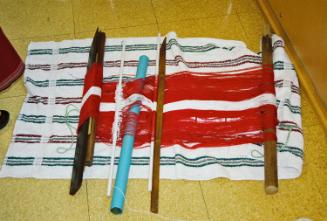Sewing Circle Gathering: Wool and Lace Artists
SubjectPortrait of
Florence Betgeorge
(Assyrian)
Date2013 May 11
Mediumborn digital video
DimensionsDuration: 1 Minutes, 7 Seconds
ClassificationsGraphics
Credit LineConnecticut Cultural Heritage Arts Program collections
CopyrightIn Copyright
Object number2015.196.750.3
DescriptionVideo of Bosnian women Sadika and Hurriya and Assyrian lacemaker Florence Betgeorge talking about lace. The conversation is in English and Bosnian. The conversation took place at a Sewing Circle Project gathering at the Institute for Community Research on May 11, 2013.
NotesSubject Note: The Sewing Circle Project began in 2007 as an initiative to encourage production, marketing, and sustainability of traditional crafts among the many immigrant and refugee communities in the Greater Hartford area and across the state. Developed by the Connecticut Cultural Heritage Arts Program (CCHAP) based at the Institute for Community Research (ICR) in Hartford and at the Connecticut Historical Society after 2015, the project supported the remarkable traditional arts of these newcomers. Members of the Sewing Circle met regularly at ICR and the Hartford Public Library to work on their art forms, learn new skills, and share coffee and conversation. This cooperative environment fostered social interaction among the artists and public audiences, respected and encouraged their cultural heritage and artistic traditions, stimulated literacy improvement, and helped to develop marketplaces for their artwork. CCHAP organized gatherings, exhibits, workshops, marketplace events, promotional materials, and educational activities for the group’s participants. While most of the artists experienced war, trauma, and dislocation, they continue to practice their cultural heritage and artistic traditions, blending these with current experiences and materials to create artwork that is both beautiful and functional. Even when immigrants and refugees embrace a move that takes them to a more stable and prosperous place, resettlement poses challenges of physical and psychological adaptation. Many new Americans have eased transition by continuing, recreating, or reinventing familiar art forms. For many members of refugee communities now living in New England, practicing their familiar arts of weaving, knitting, basket making, lace making, music, dance, and storytelling helps them to cope with the trauma of the genocide and displacement their families have suffered. Engaging with public audiences has given project participants a chance to improve their English-speaking skills and broaden their social networks and support systems. The project has been a great success because it brings some additional income to the artists and also because they have become friends and co-workers sharing techniques, styles, and supplies as they create their unusual and exquisite textiles. In collaboration with Catholic Charities Migration and Refugee Services and the Hartford Public Library, the project is expanding to offer small business training to the artists, thanks to grants from the Aurora Foundation, the Avon Hello Tomorrow Fund, the Aetna Foundation, and the Knox Foundation.
Subject Note: The Institute for Community Research (ICR) is an independent nonprofit organization which conducts applied research and community enhancement programs to promote equal access to health, education, and cultural resources. ICR's location within the community reflects its mission, which emphasizes the use of original research as a way to address serious contemporary issues and problems while strengthening community-based resources in areas of health, education and culture. CCHAP began at the Institute for Community Research in Hartford in 1991, continuing there until 2015 to research, assist, and present the state’s community-based artists along with their community histories and heritage activities.
Biographical Note: Florence Betgeorge was born in northern Iran in the Azerbaijan Province, a traditionally Assyrian Christian area. Assyrians speak a language similar to ancient Aramaic, and trace descent from the Babylonians of Mesopotamia. Florence attended Catholic school in Iran, also learning textile arts from the French nuns who ran the school. After her marriage and a move to Tehran, diplomats and other wealthy patrons commissioned baby clothes, bedcovers, and trousseaux from her. Persecution of Assyrians intensified in Iran after the fall of the Shah and during the Islamic Revolution from 1978-1982, and Florence and her family immigrated to the US in 1984. They settled in New Britain, CT where Assyrians have established a strong community with a church and a cultural center. Florence creates exquisite embroidery, lace, decorative home textiles, and she can tailor any garment. Sharokin Betgevargiz, Florence’s daughter, learned lace-making with her mother as part of the Southern New England Traditional Arts Apprenticeship Program in 2007-2008 and continues to create lace earrings, necklaces, and table covers, sometimes using unusual threads made of metal. Florence has participated in many activities of CCHAP’s Sewing Circle Project from 2007. CCHAP has displayed her work in several exhibitions. One of her knotted lace pieces is in the collection of the Connecticut Museum of Culture and History, 2015.217.0, and she donated a hand-picked handkerchief to the collection, 2015.232.0..
Florence makes lace using only a needle and 2 or 3 ply fine cotton thread, in a French style she learned from nuns. This style creates knots that secure the delicate thread as the lace strands are built up, whereas in crochet lace the stitches are continuous and unravel if pulled. She describes her lace technique as “needlework” or dentelle in French. Her special addition to this technique creates writing in lace, with scripts in Aramaic.
Additional audio, video, and/or photographic materials exist in the archive relating to this artist.
Cataloging Note: This project was made possible in part by the Institute of Museum and Library Services MA-245929-OMS-20.
Status
Not on viewFatima Vejzovic
2009 January-February








